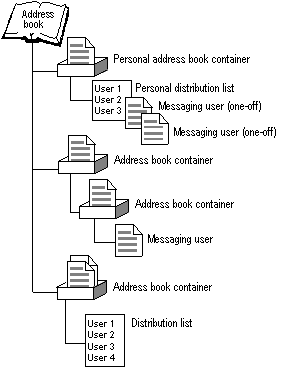
Address book providers handle access to directory information. Directory information consists of data for two types of message recipients: individual messaging users and groups of messaging users who are commonly addressed together called distribution lists. Depending on the type of recipient and the address book provider, there is a wide range of information that can be made available. For example, all address book providers store a recipient's name, address, and address type.
Each address book provider organizes this data using one or more containers. The number and structure of the containers is dependent on the address book provider's implementation. For example, one address book provider might use a single container to hold all of the information, another might use one top-level container that holds subcontainers, a third might use several top-level containers, each holding subcontainers. An address book container hierarchy can be quite deep; there is no limit to the number of subcontainers that can be used.
The following illustration shows the typical MAPI address book organization.

MAPI integrates all the information supplied by the installed address book providers into a single address book, presenting a unified view to the client application. The integrated list shows the top-level containers displayed by each of the installed address book providers. Most address book providers expose only a few containers (typically one to three) at the top level for inclusion in the top level of the MAPI integrated address book. For example, an address book provider might make available All Users and Local Users as two containers at the top level.
The users of client applications can view the contents of address book containers and in some cases modify it. Address book containers can be created with different access levels, depending on the address book provider. The MAPI personal address book (PAB) is an example of a modifiable address book container that allows new entries to be added and existing entries to be modified or deleted. The PAB is a special container because it allows users to store copies of frequently used addresses and maintains custom recipient entries, or new entries that do not exist in the information maintained by one of the installed address book providers. Custom recipients may be created for the duration of the session only or be stored in the PAB for greater longevity.
Whereas the PAB is an address book provider supplied by MAPI, it is also a role that any modifiable address book container can play. A user can take another modifiable address book container and assign it as the PAB, replacing the MAPI personal address book as the default PAB.